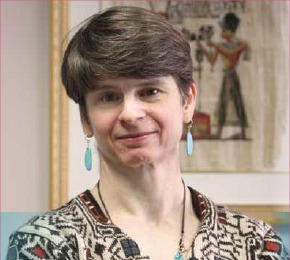League Conference: Elizabeth Merritt’s Keynote Address
 Elizabeth Merritt, the Founding Director of the Center for the Future of Museums, gave the keynote address at the League’s 2013 Conference. You can watch a video of her address on the League’s website.
Elizabeth Merritt, the Founding Director of the Center for the Future of Museums, gave the keynote address at the League’s 2013 Conference. You can watch a video of her address on the League’s website.
Futurists – what do we do? We are at the collision of two fields: future studies and museum studies. The fertile results of that collision should help the orchestra world imagine the future.
Futurists do not predict the future, and we are not about shiny robots and jet-packs. We help people imagine different potential futures within what we call “the cone of potential futures.” There are many plausible, possible futures – any of these potential futures could come to pass. We know the forces and trends shaping our world today, and as we move through the course of the future, we find ourselves heading towards many potential targets. However, we can become myopic and get blindsided if events don’t go as we expect. We need to open our imaginations to start thinking about the types of utopias we want, because things can go terribly wrong.
One of the truisms of future studies is about trying to find the hints of those potential futures in our world today. Any possible future has a toehold in the present. Museums are a little ahead of orchestras in trying to navigate these shoals/museum futures. We are in an identity crisis. You need to understand your core purpose. Many commercial companies have foundered on this. For example, Kodak was founded on the technology of film but forgot that the experience of emotions had overtaken them and can now be delivered in many ways. They forgot their core mission of sharing memories and emotions, and got hung up on the mechanism of film. Likewise SONY – they are now making most of their money through content, not through how these films get delivered.
Museums – what is the definition of a museum? I can’t tell you – museum people will argue about it endlessly. It has something to do with authenticity, with “the real thing.” But what does that mean when the Google Art Project can deliver high-quality reproductions to your computer – you can take a virtual tour of world-class museums. Is that real? They’re real reproductions of actual works…
As we try and navigate this identity crisis, we’re trying to find and hold on to the core purpose. Museums that are foundering today are ones that tried to take the whole equation of how a museum works and control every variable. This doesn’t work. Museums are having to let go of all of those habits, all of those assumptions. They must find the one true thing that they’re adhering to, and let everything else morph as the world changes. They have to rethink various assumptions.
About Place. A University of Chicago study – 1994 to 2008 – found that there was more building growth in our sector [the arts] than any other. We thought that if we got a big name architect and built a large cultural center, people would come. 80% of these projects went over budget and often the attendance projections were dead wrong.
About Time. The day of the old 9 – 5, Tuesday through Sunday, museum hours is gone. Museums are experimenting with being open in the evening – even all night.
About Content. The first Internet cat video conference was held last year at the Walker Art Center in Minneapolis. They got 10,000 nominations, and narrowed it down to 79-80 videos. They put a big screen projector on the lawn and invited people to come watch – they had 10,000 people show up to watch! It’s now gone on the road. Is this serious content? One of the curators said, “This is material culture, and one of the three most important things a museum can do is help people think critically about material, pop culture.”
About Format. It’s not necessarily going to involve four walls of the museum – you might find the museum coming to you. The Guggenheim BMW Lab’s massive portable popup museum helps cities think about urban design. What are the elements of design that make a city livable?
About Scale. Museums like the Smithsonian can be really proud of having 1 million people visit them, and then they have a 10% increase the next year. But the Internet reaches billions of people – does that make you feel a bit small? Conversely, there are museums that want to be “world class” but perhaps they should be thinking smaller in order to serve their community.
About Structure and Authority. Those are the assumptions that hobble all these other variables. The traditional museum had the director in charge of curators, who had all the status and authorities, who told the educators what they could interpret in the exhibit. Now museums are restructuring. The Oakland Museum of California has a new organizational chart that focuses on the community, because that is the core of their purpose.
When the equation balances successfully, you’ve found a core purpose that’s essential, or addictive, or ideally both. How do we balance the equation? We look at the world around us and determine how people want to consume.
People want experiences that are shareable – not just going to the museum with a friend; they want to go in with their cell phone and share it on Facebook and Twitter. This has so changed the whole premise that most museums don’t have “No photography” signs any more, except the Musée d’Orsay in Paris, where they have a protest movement that declares flash mob Sundays where they all descend on the museums and say, “We’re all taking pictures. What are you going to do, arrest us?” It’s France – they do arrest them.
People want museums to be participatory – not just an interactive exhibit. They want a hands on experience, so some museums are sharing data. They’re inviting people to get online and be curators. People are often experts about things that the museum curators are not. For example, with a historic photograph collection, you might know who’s in that photograph – perhaps it’s your grandmother. The curator wouldn’t know that. The San Francisco Museum of Modern Art presented One Minute Sculptures – the art consisted of props, pictures, and instructions and invited people to create a sculpture. People often needed help from other participants, and then they laughed and took pictures, which goes back to the social and sharing.
People want personalized experiences. Consider the Live Museum Sound project at the Hammer Museum in Los Angeles; you can pick up a resident musician who will plug into a set of headphones, follow you around, and create a personalized sound track for your museum visit.
People also want more control over the length of time of the experience. I call this “chunked” experiences. They may only have their lunch hour – so museums are suggesting, “here’s something you can do at lunch.” Museums are finding more creative ways to chunk their experiences. There’s a DVD slot built into the outside wall of the Museum of the Moving Image, part of an installation by Aram Bartholl, called Dead Drop. You go in with a blank DVD, put it in the slot, it spits it out, and you have a digital art collection that you can go home and consume at your leisure. That is chunked art.
People want their experiences to be multi-sensory. It isn’t enough just to have a visual experience anymore. Museums are finding ways to break the barrier of “don’t touch.” Because we are able to use technology tactics to create digital data and create the illusion of being able to touch the things that previously were behind the velvet rope.
And finally, people want experiences that are distributed. It’s not even just going to the museum, it’s how can the museum come to you. The Portrait Gallery of Canada took high-quality reproductions of their portraits out to the skateways so people could enjoy them while skating and playing hockey.
A lot of the things I’ve mentioned involve technology. One of the dangers of thinking about the future involves the shiny robots and the jet-packs. We get fixated on the technology. Here’s a secret – it’s never really about the technology. The technology just ignites and accelerates cultural change, and helps shape people’s expectations. People have come to expect museums, even low-tech museums, to provide them with the highly interactive, multi-sensory, and distributed experiences technology has led them to expect. Do museums have to adapt to this expectation? There are examples of successful museums that haven’t changed in 150 years. The St. Johnsbury Athenaeum in St. Johnsbury, Vermont, was founded in 1871. It has a library and a traditional art collection. It doesn’t have augmented reality, iPad tours, it hardly even has labels, and it’s beautiful and beloved by its community. And there are hardly any other museums like that in the country because it wasn’t a highly successful model in the 20th century.
There is always space to be traditional, to adhere to what worked in the past. It just may not be a very big space.
If were looking ahead to see what the majority of museums might look like in the future, let’s remember we’re not trying to predict what that’s going to be. We’re trying to imagine the different possibilities. One possibility is a fragmented world in which most museums stick to the traditional model, inside the four walls, presenting traditional authoritarian exhibits, and that’s fine. They’re going to have dedicated audiences. But all those addictive and essential art history experiences will be provided by someone else. So in this fragmented future, you can have the Google Art Project reaching out to bring art into peoples’ homes; specialized history projects for the LGBT community that brings contemporary living history to live in peoples’ home towns; educational model like Conn Academy to take art into the schools. We still has vibrant art projects, but many of them don’t live in museums.
Conversely I can see a future of ubiquity where the majority of museums have chosen to be flexible, adaptive, and immersed in their communities, and more of them may end up looking like Project Row Houses in Houston. Founded on the premise that art is essential to the well-being of the community, this project involves historic houses, and it’s about art, but it also has a laundromat (because the community needed one), a day care for working mothers, educational/vocational programs, resident artists, and it preserved those historic row houses.
My challenge to you is take those two potential futures, fragmentation and ubiquity, and fill in the word “orchestra.” In a fragmented future, if the orchestra decides to fill a vital but more constricted role, who are the other players who will step in and provide those other compelling, addictive experiences? And in a ubiquitous future, what will an orchestra look like? What are all the ways it might be embedded in the community? How might it look very different from the orchestra that you saw 20 years ago?
50 years from now, if I ask “What is an orchestra,” I might get a very different answer. It is like asking a child of today, “What is a phone?” because a smart phone is not about making phone calls – it’s about sharing. It’s about communication. That is it’s core purpose.
What is the core purpose of the orchestra? And what would it look like in a ubiquitous future?


No comments yet.
Add your comment